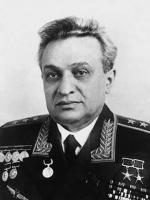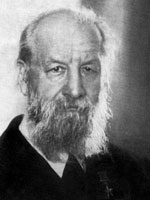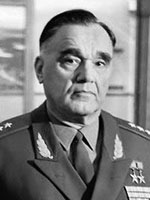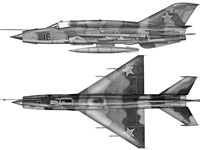Famous engineers of the past combined deep fundamental training in physics, mathematics, chemistry, materials science, strength of materials, design with daily practice and a deep knowledge of production. As a result, they do not just knew and loved his "child", but also "feel" them. This allowed them to make decisions that for others looked like inspirations ...
... The summer of 1923 the famous engineer academician Aleksey Krylov (1863-1945) by the Government of the Soviet Union order came to England to buy a few ships to transport timber from Arkhangelsk in London.
Among other vessels he examined one almost new boat suitable in all respects, but was too slow-speed - hardly a top speed of seven knots (seven nautical miles per hour - about 12.6 km / h). Alexei went to the office to the shipping company which offers this ship, and asked to become familiar with his drawings. Drawings were not available, but the owner offered to look at the ship’s model in 1/100 scale. Carefully inspecting the model, Krylov advised to trim the propeller blades for 8-9 inches (slightly more than 20 cm). According to him, after that the ship would be able to develop 9-9.5 knots, and after replacing the propeller to a new - to 10.
Not knowing who he was dealing, owner of the shipping company was politely silent. However, shortly after learning who he has been visited, gave the corresponding order and was amply rewarded: the steamer instead of seven began to make nine and a half knots!
Approximately six months later the Englishman personally went to Alexey, thanked him for the advice and asked how he could repay the outstanding engineer and scientist, and then there was this dialogue:
• I've had enough your information about the progress.
•
• I'm surprised you saw at once what to do.
•
• For thirty-two years I read a theory of the ship at the Naval Academy.
•
... In the early 1950s, the design bureau O.S.Yakovlev carried out the development of the heavy helicopter of the original enough for the time scheme - twin-screw with a longitudinal placement of the propellers on the axis of the cab. Work progressed quickly enough, but tests revealed significant vibration of the entire structure.
To resolve this issue, many specialists were invited. Some proposed to extend the helicopter, the other - to shorten, and others - to make a new design of the fuselage, and a fourth, referring to the bad experience of the Americans and the British, convinced that still does not help. The work was continued for months, but the vibration did not stop.
It seems that the situation has reached a deadlock. And then the head of the research department K.S.Kildisheva suggested cut by half a meter from each blade. The helicopter has eight of them- four on each screw; they are massive enough and rotates at a high speed.
Two weeks later shortened to 50 cm of the blades were installed on the machine, and test pilots S.G.Brovtsev and E.P.Milyutichev lifted helicopter into the sky. After a twenty minute flight pilots landed safely and by their shining faces all understood - the shaking was gone!
Launched shortly into production under the name of the Yak-24 helicopter machine has become one of the most stable in flight between all heavy and high-speed helicopters of this time. It is called "fly wagon". The cockpit of the Yak-24, 10 m, a width and a height of two meters, accommodates 40 passengers or up to 4 tons of load.
... In the mid-1950s, the design bureaus of A.I.Mikoyan and M.Y.Gurevich have developed a multi-purpose (front) fighter, who later became known as the MiG-21. Here for the first time in the Soviet Union the delta wing was used – this detail was not yet studied properly. When aircraft tests started there appeared vibration of the wing. Aerodynamics sat down for the calculations and came to the conclusion that it is necessary to shorten each console thirty centimeters. But each design change - it's an incredible number of memos, approvals, drawings and other documents. A timeline of work, was as always, tight.
Then designer Mikoyan took ingenious solution: he came to trial airfield, measured a ruler right size on the console, picked up a hacksaw and sawed off the "extra" inches - despite the protests of the chief flight station. Test flights were continued - there was no vibration.
MiG-21 became the most famous domestic second generation fighter. He had no equal in air combat during 1960-70-ies, was reliable and easy in maintenance, thereby became the most widespread supersonic combat aircraft in the world. In the Soviet Union he made serially from 1959 to 1985, he was made in Czechoslovakia, India and China. In all there were about 14,000 copies of the MiG-21, about fifty modifications. And today, as part of the Air Force in different countries continue to be about three and a half thousand "twenty-first”. The former pilots of many countries argue that it is the best aircraft from those on which they had to fly.
... As you can see, sometimes quite ordinary hacksaw can bring seemingly impossible results. But this apparent simplicity is deceptive: it stand for years and years of hard work.
There are many of similar examples. However, unfortunately, almost all of them are already sufficiently distant past. Today's designers and engineers training leaves much to be desired, and in the first place "due to" the lack of a complete production and design students practice. And I wish that the traditions of national engineering school will not lost, but multiplied in every way!
Mikulёnok
photo:
1. O.M.Krilov
2. O.S.Yakovlev
3. Mikoyan
4. Helicopter Yak-24 ("Flying car")
5. Multi-purpose fighter, the MiG-21SMT






